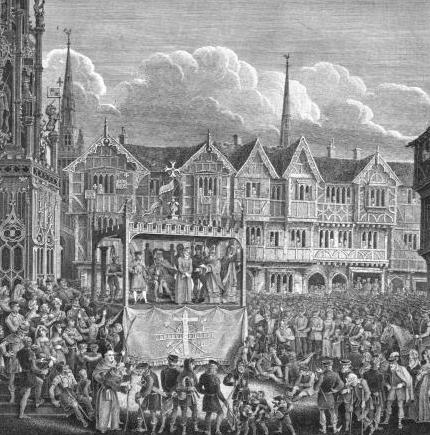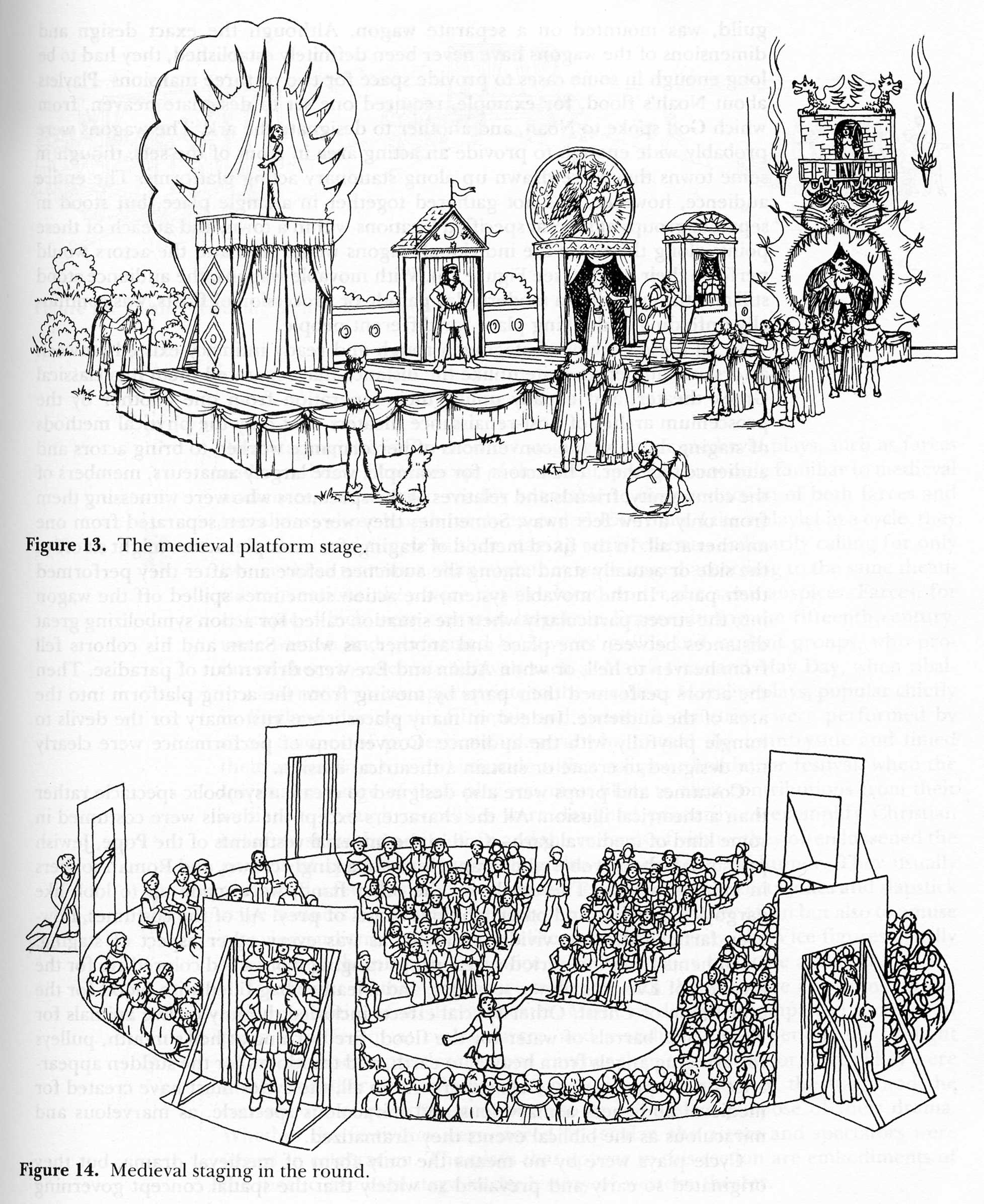~~Medieval Theatre~ Europe 400 a.d.~~
 |
| (photo by angelfire.com) |
Little is known about the theater between 600-1000 A.D.
*Medieval drama seems naïve if we don’t understand the period.
They have little sense of history – reflecting the limited knowledge of the people.
*"Anachronisms were quite common (In The Second Shepherds’ Play, for instance, the stolen lamb becomes the baby Jesus, and the Shepherds had been using Christian references even before this "baby Jesus" arrived)."
(Medieval Theatre in
Encyclopedia)
*Comic elements appeared in plays that were otherwise quite serious, and had as their purpose to teach Biblical stories and principles to the people.
*"The medieval mind looked at the temporal world (Earth) as transitory; Heaven and Hell were the eternal realities.There are references to actors (histriones), jugglers, rope
dances in nomadic tribes, remnants of Roman mimes, popular pagan festivals and
rites) (
Mystery Play).
Mystery Play).
There was little written drama; none that survives, and
almost no other surviving references to it.
****Also Christian ceremonies, where the theatre seems to have
been "reborn."****

( Photo by prop agenda)
"Between 925 and 975, drama becomes re-introduced into the
church services.
Theatre was "reborn" within the very institution
that helped to shut it down.
Perhaps the church had little choice – it couldn't stop
the pagan rites – too popular – so many aspects of pagan rites found their way
into Christian ceremonies. (Christmas the birth of Christ, not celebrated in
December till the 4th century, to take advantage of the winter festivals;
Easter supplanted the spring festivals).
In the 12th century, the Crusades helped bring other
cultures to Europe (or, to be more accurate, Europeans took from other cultures
and brought them to Europe). " (Medieval
Theatre in Encyclopedia)
~"Liturgical Drama"~
– within the church liturgy, the service
Other religious dramas extended outside the church, in the
vernacular [native language]
Earliest extant drama from the middle ages:
"a four-line dramatization of the resurrection, with
direction for its performance.
Comes from an Easter trope (interpolation into existing
text, originally lengthened musical passages with words eventually added). –
925 A.D. "(
Sung by a choir at first
called the "Quem Quaeritis"
"Whom seek ye
in the tomb, O Christians?
Jesus of Nazereth,
the crucified, O heavenly beings,
He is not here, he
is risen as he foretold;
Go and announce
that he is risen from the tomb."
By 975, it had become a little drama within the service,
probably played by altar boys.
At first, the church had control of the drama outside of the
church, but then it gradually became more controlled by secular groups.
~The Guilds~
Accordiing the the book by Ronald Vince, Ancient
and Medieval Theatre, "(tradesmen or Confraternities) took over in some
cities, and it was common for certain Guilds to retain control over certain
plays / stories, all of which were based in some way on the Bible or religious
teachings" (153)
For instance, the Bakers’ Guild would control the play about
the Last Supper, and Shipwrights’ Guild would get plays about Noah, etc.
Municipalities took over in some cities. But the church
still needed to approve the scripts, even when its role diminished.
 |
| (Photo by Medieval theatre in Encyclopedia) |
There were two main areas for the performances to take
place:
"Mansions -- small
scenic structures for indicating location (for instance, a throne might equal
the palace of Pilate).
In more complex plays, there were many mansions.
Platea – general
acting area, adjacent to the mansion.
The church structure usually served as the mansions (the
choir loft, for instance, could serve as heaven; the altar might be the tomb of
Christ)." (Medieval theatre in Encyclopedia)
 ~The Religious Plays~
~The Religious Plays~
~The PLAYS EXTRAS~
Two major kinds of stages in the medieval theatre: Fixed and Movable
These technical tricks would be more extensive on fixed
stages.
The mansion and platea were borrowed from the church
services.
Simultaneous display of several locations also borrowed from
liturgical drama-
Simultaneous staging was a distinctive characteristic of
medieval theatre.
Fixed Staging: on the Continent (except Spain and parts of
Italy) (W&G call them "platform stages)
Mansions set up in available spaces (courtyards, town
squares, etc.), usually arranged in straight lines or rectangles or circles,
depending on the space.
Heaven and Hell were at opposite ends, if possible.
Movable: PAGEANT WAGONS (WiseGeek.com)

Performed in cycles.
Three kinds of religious plays:
-- Mystery plays –
about Christ or from the Old Testament – usually done in cycles (Second
Shepherds’ Play is one of these).
-- Miracle plays –
lives of saints, historical and legendary
-- Morality plays
– didactic allegories, often of common man’s struggle for salvation (Every man –
only his good deeds accompany him in death). - With diminishing church control, secularization led to some
changes.
Sometimes the plays were very complex – in cycles – that
someone was hired to oversee.
- The master copy of the script was called the Register –
sometimes the producing company / guild could monopolize or censor it or ban it
--
- The Keeper of the Register was an important position and had
much control.
- The Master of Secrets – was in charge of the machines
(secrets) – the special effects.
Often very intricate (need 17 people to operate Hell
machinery in Belgium in 1501).
Flying was a major technique.
- Quite common – almost all the scenes had Heaven on the
right, Hell on the left, and Earth on the middle.
- Therefore, angels, resurrection – had to use flying.Platforms covered with cotton (the "glories") held
angels.
Trap doors – appearances and disappearances (Lot’s wife turning into salt, etc.)
Fire – the hellmouth – a fire-breathing monster representing hell.
Medieval Staging
~Theatre
Props~
 |
| (Photo by Medieval theatre in Encyclopedia) |
How
were props made in Medieval Theatre?
"
Before Shakespeare's time, European theatre consisted of Festivals and
traveling religious pageants. Trade guilds were maturing into full-fledged
institutions by the fourteenth century. It would seem that most of the props
(and other production values) were provided by these guilds” (Prop Agenda)
Machinery
was also used: to fly Christ up to heaven, have angels come down, etc.
Costumes
were more than likely ordinary church vestments
*By 1200, some of these plays were being performed outdoors.
*By 1350, plays were in the vernacular, rather than Latin.
Laymen were the actors (male members of the community, unpaid—though there were some women on stage in France), no longer clerics and priests.
 |
| (Photo by University of Gothenburg) |
~The Decline of Medieval Theatre~
Increased interest in classical learning – affected staging
and
Social structure was changing – destroyed feudalism and
"corporate" nature of communities
Dissension within the church led to prohibition of religious
plays in Europe (Queen Elizabeth, the Council of Trent, 1545-1563 – religious
plays outlawed.).
By late 16th century, drama of medieval period lost its
force.
Results of the decline:
Professional actors still needed, but not amateurs.
Professional theatre rose, became commercial (no longer a
community venture).
No longer religious plays – returned to the classics for new
ideas for stories.
Works Cited
McAtee, Marjorie, and W. Everett. WiseGeek.
Conjecture, n.d. Web. 08 Mar. 2013.
"Medieval Theater." Medieval
Theater. N.p., n.d. Web. 08 Mar. 2013.
"Medieval Theatre in
Encyclopedia." Medieval Theatre in Encyclopedia. N.p., n.d. Web. 08
Mar. 2013.
"Need Theatre Masks." Http://www.angelfire.com.
N.p., n.d. Web. 8 Mar. 2013.
Vince, Ronald W. Ancient and
Medieval Theatre: A Historiographical Handbook. Westport, CT: Greenwood,
1984. Print.
"Voices of Late Medieval Peasant
Women and Men Heard Again after 500 Years of Silence." Göteborgs
Universitet. N.p., n.d. Web. 08 Mar. 2013.

No comments:
Post a Comment